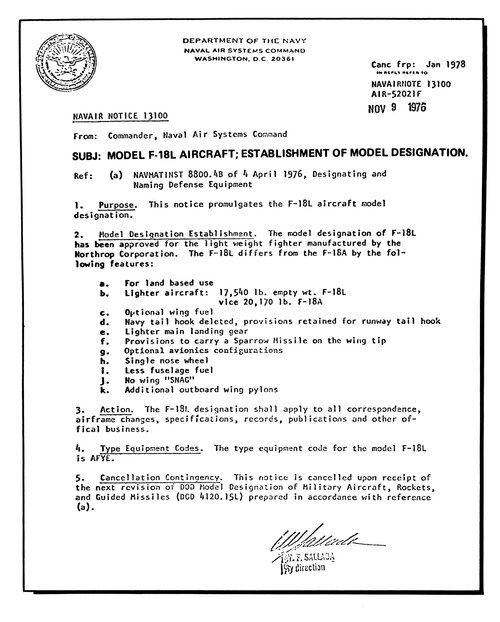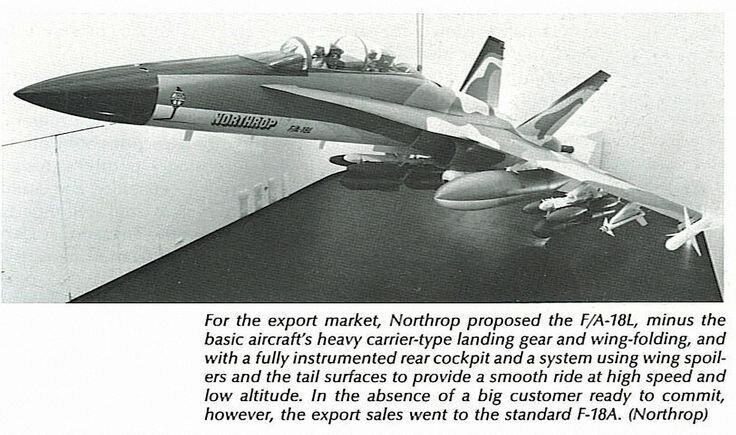Northrop Readies 1976 F-18l Export Sales Push
CECIL BROWNLOWJUNE 71976
Northrop Readies 1976 F-18L Export Sales Push
Cecil Brownlow
Los Angeles—Northrop Corp. hopes to begin a full-scale export marketing program for a land-based version of the McDonnell Douglas/Northrop F-18 carrier-based single-seat fighter by late summer or early fall.
Initiation of a full-blown program and overseas sales effort are being delayed until the Navy F-18 project has been firmed and delivery dates established so that there will be no possibility of any manufacturing conflicts between the two, according to Thomas V. Jones, Northrop chairman of the board and chief executive officer. The land-based
version of the F-18 will be aimed solely a t the export market, as is the Northrop F-5 series, with no thought of potential sales to the U. S. military, Jones told AVIATION WEEK& SPACE TECHNOLOGY.
No formal identification has yet been assigned the aircraft, which Jones refers to as the LBV for land-based version. Navy officials in Washington call it the F-18L (land-based), and there is some sentiment to name it the Cobra 2, a designation well known on the military export market.
The original Cobra was designed for the export market by Northrop (AW&ST Apr. 23, 1973, p. 55) and then evolved into the YF-17, the losing contestant against the General Dynamics YF-16 in the Air Force lightweight fighter flyoff competition. The YF-17, in turn, formed the core for the F-18 design, with McDonnell Douglas assuming the role of prime contractor because of its past experience with carrier-based aircraft.
Northrop will take over the role as prime contractor and final assembler for, the land-based aircraft, with McDonnell Douglas as the major airframe subcontractor, although final details of just what each company will produce are still to be worked out, according to Jones.
McDonnell Douglas probably will build the wing and other horizontal surfaces of the aircraft, while Northrop will assume responsibility for the armaments system, engine installation and possibly the nose avionics package as well as final assembly. McDonnell Douglas will be re-
sponsible for approximately 60% of the Navy F-18 airframe as well as for final assembly.
Defense Dept, and Navy officials in Washington are pleased with Northrop’s decision to push a land-based version of the aircraft on the export market because additional sales of a fighter with high commonality with the F-18 could reduce substantially the latter’s unit cost to the U. S.
Defense Dept, officials also confirm Jones’ contention that there will be a large export market for the aircraft despite the head start of the F-16 and its selection by a four-nation North Atlantic Treaty Organization consortium. The LBV, according to Jones, is designed to be an all-purpose successor to the McDonnell Douglas F-4, with capabilities to perform as an interceptor, in the close-support role and as a long-range interdiction aircraft.
Jones foresees a market for an advanced tactical fighter of 3,000-4,000 aircraft, including the 800 F-18s on order by the Navy and Marine Corps. He believes “conservatively” that the land-based version of the F-18 can capture up to 2,000 of these sale°
At the same time, he stresses that his aircraft is not in a head-on competition with the USAF-backed F-16 because of the LBV’s mission versatility. In this regard, he points out that he withdrew his salesmen on the F-17 from Europe when the Air Force selected the F-16 as the winner in its lightweight fighter competition.
Northrop has discussed in general terms the capabilities of the land-based version of the F-18 with a number of countries, most specifically with Iran.
Jones adds that, by approving production of the LBV, the Navy will have the no-cost advantage of additional static tests to confirm the design parameters of its aircraft, more flight tests, reduced facility overhead and near-concurrent orders for major common systems such as the General Electric F404 16,000-lb.thrust engine that should drive downwards the unit price for the F-18. Engine orders could double, depending on the quantity of export sales.
YF-17 Exhibit Plan
Northrop Corp. hopes to negotiate Air Force permission to exhibit its YF-17 lightweight fighter prototype at England’s Farnborough air show Sept. 5-12.
Primary purpose would be to demonstrate the potential of a land-based version of the Navy F-18, which evolved from the YF-17 design and which Northrop plans to develop for export.
Two YF-17 prototypes were built for the Air Force lightweight fighter competition eventually won by the General Dynamics YF-16. USAF retains title to both, although one has been detailed to NASA for flight test purposes.
Jones says the LBV should follow closely in the development cycle on the heels of the Navy F-18 in order to take advantage of these cost-saving measures, but not so closely as to impair the latter’s schedule. This was one of the reasons, he says, that McDonnell Douglas, rather than Northrop, is the prime contractor for the carrier-based F-18.
The Navy can make whatever changes it desires to the basic F-18 design, and McDonnell Douglas can concentrate on them without having to consider any impositions upon the land-based aircraft. Northrop’s management, in turn, can concentrate upon the LBV without having to debate whether its decisions will affect the carrier-based F-18.
The LBV’s performance will be substantially above that of the Navy aircraft because of less pressing structural requirements than those demanded for carrier operations and the combat radius stipulated by the Navy carrying only internal fuel.
The land-based aircraft will be about 7,000 lb. lighter than the F-18, and 3,500 lb. of this is reduced fuel load. Landing gear weight will be about half that of the Navy aircraft because of the lower sink rates required for land aircraft, and there will be no requirement for a folding wing. The arresting gear will be considerably lighter, and the avionics package will be simpler. The reduced weight, with the same thrust engine and the same aerodynamic design, provides the superior combat performance that Jones believes will make the LBV attractive as an F-4 successor on the export market.
The only apparent aerodynamic difference between the Navy F-18 and the LBV is the elimination on the latter of a wing slot required for high angle of attack carrier landing approaches.
Approximately 60% of the parts will be common by weight. Commonality in the high-use systems will run 85-95%.
Northrop, in current studies, is financing the LBV project with its own funding and, according to Jones, will ask for no U. S. government aid. Northrop, he says, will accept full responsibility for financing the project throughout, adding: “The defense industry should do its own financing for export products. We can’t expect Congress to fund our plants and facilities [for export items].” Approximately 94% of Northrop facilities are companyowned at the present time.
Jones believes the LBV performance permitting it to carry out missions as a close-support aircraft, interceptor and interdictor will prove effective to budget-restricted nations requiring a replacement for the F-4 in the 1980s. Coproduction eventually may be offered to export customers, but initial sales are envisioned as off the shelf.











